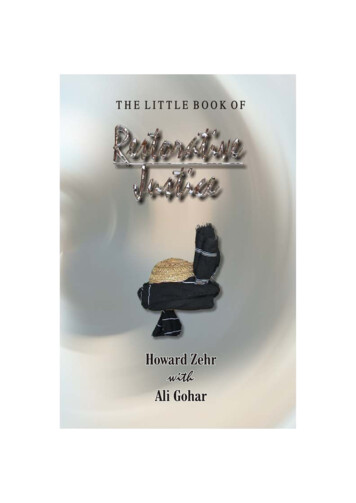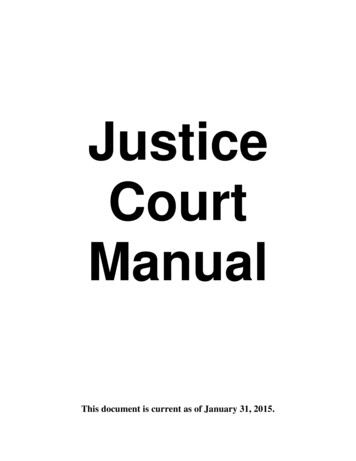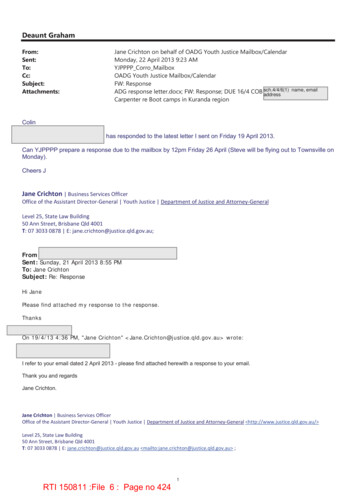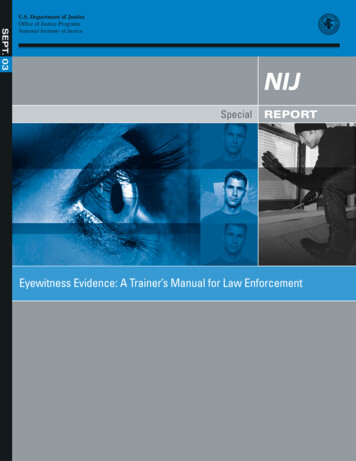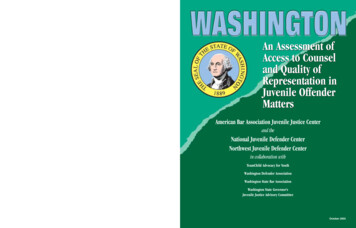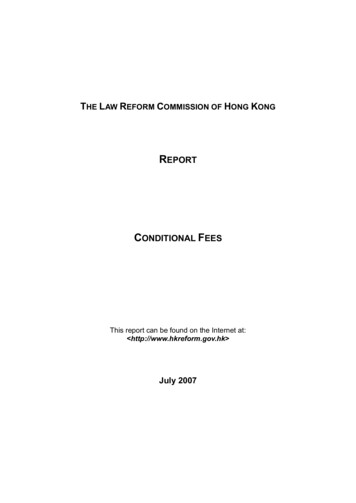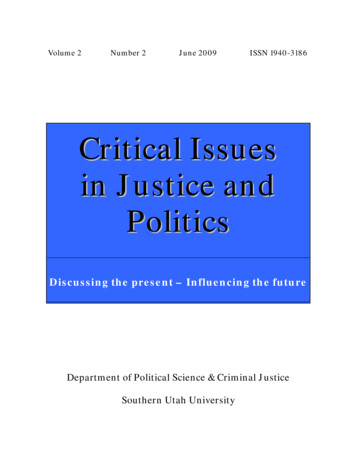
Transcription
Volume 2Number 2June 2009ISSN 1940-3186Critical Issuesin Justice andPoliticsDiscussing the present – Influencing the futureDepartment of Political Science & Criminal JusticeSouthern Utah University
Critical Issues in Justice and PoliticsVolume 2 Number 2 June 2009ISSN 1940-3186Copyright 2009 Critical Issues in Justice and PoliticsAll rights reserved. No part of this publication may be reproduced, stored,transmitted, or disseminated, in any form, or by any means, without prior writtenpermission from Critical Issues in Justice and Politics. The journal CriticalIssues in Justice and Politics is an academic extension of the Department ofPolitical Science and Criminal Justice at Southern Utah University.Editorial Contents – The contents of each article are the views, opinions, or academic inferencesof the individual article author. Publication of each article may not reflect the views or positionsof the journal, the department, or Southern Utah University. All material is published within thespirit of academic freedom and the concepts of free press.
Editorial OfficeDepartment of Political Science and Criminal JusticeSouthern Utah University351 University Blvd., GC406Cedar City, UT 84720Phone: 435-586-5429Fax: 435-586-1925University Webpage: http://www.suu.edu/Department Webpage: http://www.suu.edu/hss/polscj/Journal Webpage: http://www.suu.edu/hss/polscj/CIJP.htmEditorCarl FranklinAssociate EditorSandi LevyFaculty & StaffG. Michael Stathis - Department Chair – Phone: 435-586-5429; OfficeGC406NPolitical ScienceRandy Allen – Phone: 435-586-7949; Office: GC 406EJohn Howell - Phone: 435-865-8093; Office: GC 406HLuke Perry – Phone: 435-586-7961; Office: GC 406MG. Michael Stathis - Phone: 435-586-7869; Office: GC 406KCriminal JusticeDavid Admire – Phone: 435-586-1926; Office: GC 406JCarl Franklin - Phone: 435-586-5410; Office: GC 406LTerry Lamoreaux - Phone: 435-865-8043; Office: TH 109John Walser - Phone: 435-586-7980; Office: GC 406FWayne Williams - Phone: 435-865-8613; Office: GC 406G
Critical Issues in Justice and PoliticsVolume 2 Number 2 June 2009ISSN 1940-3186ContentsSubscription Information . iSubmission Guidelines. iiArticlesCollege Education as a State-Wide Licensing Requirement:An Analysis of the Minnesota Model 30 Years LaterSusan M. Hilal & Timothy E. Erickson.1The Justice of ‘Just Desserts:’ An Examination of theCrossroads Correctional CenterAngela G. Dunlap & Dennis Hill.20The Rhetoric of a Liberal JudiciaryMichael Bogner & Luke Perry.41Legislative Opinions Concerning Terrorism Response FundingAnd Likelihood of Attack: The Case of TexasJames J. Vardalis & Shannon N. Waters .57Which Came First, The Bond or Self-Control? A Test ofHirschi’s Revision of Low Self-ControlMichael A. Cretacci .71Police Corruption or Police Productivity?Officers Perceptions of Moonlighting in U.S. AgenciesDavid A. Jenks .87Criminal History That Repeats .and Punishes .Severely:How Career Drug Offenders Relive Their Past Under the FederalSentencing GuidelinesRichard H. Hubbard .105
Subscription InformationCritical Issues in Justice and Politics is a refereed (peer-reviewed)journal which contributes to the theoretical and applied nature ofjustice and politics. We are a scholarly journal which requires allarticles to undergo an extensive review process for both content andformat. Our emphasis is on the exchange of qualified material inorder to generate discussion and extend the often limited boundariesof scholarly exchange.Critical Issues in Justice and Politics is sponsored by the Departmentof Political Science and Criminal Justice at Southern UtahUniversity. The editorial board is comprised of faculty from thedepartment as well as select faculty and practitioners from around theUnited States.Published three times a year (Winter, Spring & Fall), Critical Issuesin Justice and Politics focuses on emerging and continuing issuesrelated to the nature of justice, politics, and policy. A specialemphasis is given to topics such as policy, procedures and practices,implementation of theory, and those topics of interest to the scholarand practitioner alike.Nature of Electronic Publication:Critical Issues in Justice and Politics is considered a serialspublication under definitions by the Library of Congress and theInternational Standard Serial Number (ISSN) system. The ISSNnumber, along with identifying information for the serial publication,appears on all copies of the journal. The journal may be obtainedonline or through many of the traditional research databases inacademia.Because we publish online we provide a wider audience than mostsmall, scholarly journals. The cost of other journals can berestrictive; often making purchase and use of the journal difficult fori
the average faculty member. With our electronic format we provideaccess to the journal at no cost to qualified subscribers. Thisprovides a larger audience with increased opportunity for those whowish to publish.Copies are distributed via email and online access to subscribers first.Authors receive access to the electronic copy and may purchase printcopies.We are an electronic journal which is published using the PortableDocument Format (PDF).Submission GuidelinesCritical Issues in Justice and Politics welcomes submissions fromanyone who can write a high quality scholarly article. We areespecially interested in scholarly, critical, and constructive articleswhich focus on an emerging or continuing issue in justice andpolitics. We also seek review essays (reviews of recent literature ona given topic), reports of significant justice or political issues, bookreviews, and position papers worthy of scholarly review andcomment.It is the editorial policy of Critical Issues in Justice and Politics toaccept submissions from all disciplines so long as the material relatesto justice and/or politics. We also encourage submissions frompractitioners, students, and others who have an interest in the topics.Simultaneous SubmissionsWe prefer manuscripts which are not under review by other journalsor publications. We endeavor to review all manuscripts in a timelyfashion, so simultaneous submissions are not usually necessary.Refereed submissions are submitted within forty-eight hours ofacceptance and we generally ask reviewers to complete theirii
assignment within 10 working days. In most instances an editorialdecision may be reached within a month of submission.Non-refereed materials usually receive attention within the first weekof submission. An initial editorial decision is often made within 5business days.All papers submitted for refereed publication will be sent to at leasttwo reviewers. We use a blind-review process which submits papersin anonymous format. If there is a clear split between the reviewersthen a third reviewer may be used when necessary for clarification oradditional comment. We do rely very heavily on our reviewers forinsight and recommendations. All of our reviewers hold theappropriate degree and experience to qualify them for the particularproject.Reviewers are asked to evaluate manuscripts on the basis of theirscholarly competence as well as the potential contribution toappropriate theory or related areas. Authors may not contactreviewers during the process, and reviewer names are not disclosedunless the reviewer agrees to such disclosure.Authors who dispute the findings or suggestions of a reviewer maysubmit their response in writing. Final decisions on publicationremain the domain of the editorial board.For more information or to submit an article or other material forreview please see our webpage.Journal Webpage: http://www.suu.edu/hss/polscj/CIJP.htmiii
ADVERTISEMENTThis 36-credit-hour degree can insure your futuresuccess in the public or non-profit sector!) Small Class Sizes) Accessible Faculty) Application Deadline August 1, 2009For more information:http://www.suu.edu/hss/polscj/MPA.html
1College Education as a State-Wide Licensing Requirement:An Analysis of the Minnesota Model 30 Years LaterSusan M. HilalMetropolitan State UniversityTimothy E. EricksonMetropolitan State UniversityThe following study contributes to the growing body of literature regardingpolice education. A previous education study of Minnesota officers wasconducted by the Minnesota Board of Peace Officer Standards and Training in1990. In May of 2008, using a list of all full-time licensed municipal andcounty Minnesota peace officers (N 9,386), Hilal and Erickson replicated amajority of the 1990 study by distributing a self-administered survey to arandom sample population of 1,099 officers, with a response rate of 57%(N 627). The purpose was to answer four main research questions involvingeducational levels of peace officers, perceived agency support for education,perceptions of officers regarding the four-year degree requirement forlicensure, and the employment of female and minority officers. Comparisonsof the 2008 data to the 1990 data are made. Results indicate that currentMinnesota peace officers have increased their level of education and attendanceat all levels of higher education, perceptions of agency support remain mixed,current support for a four-year degree requirement has decreased, and female orminority officers continue to be employed as peace officers at increasingnumbers.IntroductionThe sources that have called for higher educational standards for peaceofficers in the United States have been many and varied, ranging from theindividual proponents of police professionalism in the early 20th century, tonational studies commissioned to review the failure of law enforcement agenciesto effectively control crime and provide peacekeeping services over the ensuingdecades. Academics joined the discussion as early police studies and criminalDr. Susan Hilal is an Assistant Professor in the School of Law Enforcement and Criminal Justice atMetropolitan State University in St. Paul, MN. Her areas of research interest include police education and volunteerism.Prior to working at Metropolitan State University she was an Assistant Professor at the University of WisconsinPlatteville. She earned her PhD in Sociology from South Dakota State University in Brookings, SD, a MS in CriminalJustice from St. Cloud State University in St. Cloud, MN and her BA in Criminal Justice from the University of St.Thomas in St. Paul, MN.Timothy Erickson is an Assistant Professor in the School of Law Enforcement and Criminal Justice atMetropolitan State University in St. Paul, MN. He teaches a variety of courses in both law enforcement and criminaljustice and serves as the coordinator of the online major completion program designed for licensed Minnesota peaceofficers. His research interests include peace officer education issues, the police socialization process and ethical issuesin criminal justice. He is a former peace officer, patrol supervisor, criminal investigator and chief of police with 24 yearsof practitioner experience in both Minnesota and Arizona. He earned his graduate degrees at the University of Wisconsin,River Falls.
COLLEGE EDUCATION AS A STATE-WIDE LICENSING REQUIREMENT2justice programs began to develop at major universities, prompting the use ofresearch methods in analyzing law enforcement functions and policies, to includeeducation and training standards. Despite this nearly century long examinationof the relationship between education and law enforcement, few quantifiableanalyses have been conducted to determine the current education level of peaceofficers, or effective ways to increase the level of education of individualofficers.Much of the discussion of peace officer education has focused onattempting to resolve a question that defies a simple empirical answer; that is,does increased education result in any observable, quantifiable difference in thequality of peace officer effectiveness? As those who have reviewed the researchhave observed, the answer to the question has often been confused, conflictingand rife with problems associated with the various research methodologies usedto examine the issue. As a result, there has been little progress in theimplementation of higher education requirements for law enforcement personnelat the local and state levels. There has, however, been one noticeable exception.In 1977, the Minnesota legislature enacted legislation that created the firstlicensing system for peace officers in the United States. This legislation resultedin the creation of the Minnesota Board of Peace Officer Standards and Training(hereafter referred to as the Minnesota POST Board or cited as MN POST).Although many states have similar law enforcement agency certification boardsthat are often referred to as POST boards, the Minnesota POST Board was givenboth licensing authority (referred to as certification in most other states) and theauthority to determine minimum education requirements for all newly licensedpeace officers in Minnesota (MN POST, 1991). Subsequent to its creation, theMinnesota POST Board in 1978 identified a two-year college degree as theminimum education requirement for all new entry level officers, becoming thefirst state to mandate a college degree as the entry level hiring requirement.Officers hired before 1978 were “grandfathered” into the new licensing process.While there are individual agencies in other states that have adopted bothtwo-year and four-year degree requirements (see for instance Bowman, 2001;Carter, Sapp & Stevens, 1989; Police Association of College Education [PACE],2008; Travis, 1995), to date no other state has followed Minnesota’s lead inrequiring a post-secondary degree for entry level licensing or certification. Theremay be many reasons for this fact, and the research literature suggests thatopponents of post-secondary requirements for law enforcement often cite thedisparate impact that these minimum education requirements will have onrecruitment of new officers, especially women and candidates of color (Decker& Huckabee, 2002; Kim & Mengistu, 1994; Williams, 1992). In addition, therehas been considerable debate as to whether post-secondary education results in
SUSAN M. HILAL & TIMOTHY E. ERICKSON3producing more effective peace officers than the traditional police academy. Thehistory of policing is of course rife with both insularity in terms of training andeducation of officers as well as antipathy toward higher education, oftenescalating to anti-intellectual or anti-educational levels.Despite ongoing concerns about raising educational standards for peaceofficers, during Minnesota’s 1990 legislative session two state representativesintroduced initial legislation that would have raised the requirement for entrylevel peace officers in Minnesota to a four-year degree after January 4, 1994.This legislation was subsequently amended (most likely in part due to theconcerns listed above) to provide for a study of the Minnesota peace officereducation system, resulting in the publication of the 1991 Minnesota POSTBoard study. As part of this study, the legislation requested that the POST Boardreport back to the legislature to provide recommendations relative to the issue ofrequiring the four-year degree as a minimum education requirement for officers.One of the outcomes of the study was the following, clearly lukewarm support ofthe four year degree in their report to the legislature: “The [Minnesota] POSTBoard supports in principle, the attainment of a baccalaureate degree by all peaceofficers who aspire to this goal, but does not support mandating a baccalaureatedegree as a prerequisite for licensing” (MN POST, 1991, p.1, SuggestedImplementation Strategies).In addition to other implementation strategies, the Minnesota POST studyprovided the first documentation of baseline data describing the education levelof Minnesota peace officers. Published fourteen years after the initial legislationestablishing the Minnesota POST Board, it provides an early evaluation of theeffect of the two-year degree licensing requirement on peace officer educationlevels, attitudes toward higher education and future educational aspirations. Thisprevious study and its baseline data served as a replication model fordevelopment of the survey used in the current study, and for comparisonpurposes in observing quantifiable changes that have occurred since the initiallicensing process began.In 2008, the authors of the current research distributed a survey to aprobability sample of 1,099 local and county Minnesota peace officers. Thissample population represented approximately 12% of all local and county fulltime Minnesota officers (the Minnesota POST Board database indicates a total of9,386 local and county officers). The 2008 survey replicated many of the itemsused in the 1990 study and introduced several additional items. The datacollected in the 2008 survey was then compared to the baseline data collected inthe 1990 Minnesota POST study. The authors of the current study attempted toanswer four main research questions that will be discussed more fully in the
COLLEGE EDUCATION AS A STATE-WIDE LICENSING REQUIREMENT4methodology section, but focused on the observable effect of the Minnesota’stwo-year degree requirement eighteen years after the first study was conducted.The following section will more fully examine the literature and researchrelevant to the role of higher education in policing. As discussed previously,while there are few answers regarding the quantifiable effect that highereducation has on peace officer effectiveness, the debate has informed much ofthe previous research in this area.Review of LiteratureResearch regarding the role of higher education in peace officerpreparation can be found in both historical literature and contemporary research.Most discussions of the origin of the higher education movement in lawenforcement begin with an examination of the influence of August Vollmer andhis protégé, O.W. Wilson. Vollmer (1932) is well-known for his role andparticipation in the drafting of the reports of the Wickersham Commission.These reports appear to be the first governmental initiative calling for increasededucation of the police with advocacy of college preparation. However,Vollmer’s aggressive efforts to professionalize policing began much earlier whenhe was the chief of police in Berkeley, California and later when he wasassociated with the University of California-Berkeley and assisted in theestablishment of the first school of criminology (Carte & Carte, 1975; Douthit,1975; Vollmer, 1933). Vollmer was later to become one of the founders and thepresident emeritus of the American Society of Criminology (Morris, 1975), andhe played a primary role in the development of the first police school in a postsecondary education institution at San Jose State College (MacQuarrie, 1935).One cannot mention Vollmer without also discussing the influence ofO.W. Wilson in the professional movement. Although Wilson has primarilybeen associated with the professionalization of police administration, Hoover(2005) suggests that his contributions go far beyond this accomplishment and hisassociation with police education and police science are exemplified by hiscommitment to “an open-minded, scientific approach to assessing what works inpolicing” (p. 8). Wilson is most often identified with his seminal text PoliceAdministration, often referred to as the “bible” of police administration duringthe professional movement in law enforcement. Both Vollmer and Wilsoncertainly must be considered the early pioneers in the advocacy for collegeeducation for peace officers and police managers.The President’s Commission on Law Enforcement and the Administration of Justice (1967a, 1967b) produced two publications, The Challenge ofCrime in a Free Society and Task Force Report: The Police, that both suggestedthat one solution to improve the effectiveness of police would be to require
SUSAN M. HILAL & TIMOTHY E. ERICKSON5higher education for entry level peace officers. These reports prompted thedirection of significant federal resources toward the criminal justice system,creating several agencies and mechanisms designed in part to train and educatethe police, operationalized by the passage of the Omnibus Crime Control andSafe Streets Act of 1968. The Act initially created the Law EnforcementAssistance Administration (LEAA), which was later absorbed by the NationalInstitute of Justice. It also established Law Enforcement Education Programs(LEEP) which provided funding to peace officers to attend or return to college topursue higher education. The historic result of the Commission reports has beenthe development of massive funding for criminal justice research, much of whichfocused on police training and education. These funds in turn have arguablyresulted in the formation of such professional organizations as the PoliceExecutive Research Forum (PERF) in 1977, the Commission on Accreditationfor Law Enforcement Agencies (CALEA) in 1979, and more recently thedevelopment of the Office of Community Oriented Policing (COPS).In addition to the national initiatives, the Commission reports alsoprompted the development of many of the current state POST Boards. Theseboards often evolved from earlier iterations of state police training organizations– this was the case in Minnesota when the MN POST Board and its system ofprofessional peace officer education was created in 1977. It replaced the preservice training previously provided by the Minnesota Bureau of CriminalApprehension. Currently these state organizations are members of theInternational Association of Directors of Law Enforcement Standards andTraining (IADLEST). One of the stated missions of IADLEST is to assist policetraining organizations with the development of training standards. Similar to theMinnesota POST Board, IADLEST has also given lukewarm support for highereducation of peace officers in its model minimum standard for education whichstates:State law or commission regulation should require immediatelythat all persons hired as police or corrections officers possess at aminimum a high school diploma, and should ultimately seek tophase in an entry-level requirement of a baccalaureate degree froma college or university accredited by a regional postsecondaryaccrediting body . (IADLEST, 2008, standard 2.0.9)As rationale for the increased standard of the postsecondary degree IADLESTsuggested that as communities moved toward community policing (admittedly anassumption on the part of the organization), a college education becomes“increasingly desirable.”
COLLEGE EDUCATION AS A STATE-WIDE LICENSING REQUIREMENT6Additional proponents of higher education for police can be found inother professional organizations, and both public and private non-profit sectors,to include the American Civil Liberties Union, the National Association for theAdvancement of Colored People, and the American Bar Association (see forinstance, American Bar Association, 1980, standards 1-7.2. and 1-7.3). A morerecent non-profit organization, the Police Association for College Education(PACE), was created and advances a mission of encouraging and facilitating aminimum education level of a four-year degree for officers (PACE, 2008),suggesting that this goal has been advocated by numerous national commissions,the federal courts as well as the organizations listed above.It can be summarized that the research on police education has tended toinvestigate two broad themes; the role that formal education might play inimpacting the attitudes and behavior of police officers, and the role of educationin improving the performance of officers. While it might be assumed that therewould be a correlation between these two foci, much of the research wouldsuggest otherwise.One issue operating in the discussion of these issues is fueled by thedebate concerning the importance of “skills training” versus that of formaleducation relative to police officers. This debate has been a continuing one sincethe development of the first police school at San Jose College; at that timeMacQuarrie (1935, p. 257) suggested that specific technical training was “themost important part of the semi-professional program,” allowing that “probablyin the end a four-year program will be found advisable, as is now the case withteachers.” This tension between training that is seen as the practical applicationof police skills, and the broad based liberal arts education that is implied in thebaccalaureate degree, oftentimes results in viewing training and education asbeing two separate rather than integrated processes. In Minnesota, this tensionplays out in the fact that the three largest law enforcement agencies in the stateput new officers through an internal police academy of substantial length. This isdespite the fact that these new officers have already earned a two-year or fouryear degree, which has included both clinical skills and academic components ofpre-service education, and have passed the state peace officer licensing examnation.A second issue involves the research that has suggested that the policesocialization process is so strong as to negate any advantage of formal highereducation. Anecdotal reports are legend of the police academy instructors orfield training officers who clearly express their derision for formal education bydemanding that new officers forget what they learned prior to arriving at thedestination that will teach them how things work in “the real world.” It might besuggested that the situation in Minnesota regarding the police academies in the
SUSAN M. HILAL & TIMOTHY E. ERICKSON7three agencies described above is perhaps more a reaction to the perceived needto “socialize” new officers into these three departments, than an indication thatthe education received in the college or university institutions is somehowlacking. This “socialization” process most likely occurs in the remaining 641Minnesota agencies through some kind of field training officer (FTO)experience.In summary, despite the call for higher education for peace officers thathas come from many venues, reaching this goal has proven to be elusive. Theadvancement to post-secondary minimum education requirements for officershas been thwarted by at least three issues: 1) conflicting findings in the research;2) disagreement on the pedagogical issues; and 3) with the exception ofMinnesota, a movement beyond the traditional police academy model has beenvirtually non-existent.The following section will examine the influence of a higher educationrequirement as evidenced in the Minnesota experience. Because it is the onlystate model that goes beyond traditional academy training as the entry leveleducation requirement, it has potential for informing future research regardinghigher education for peace officers.MethodologyA previous study of Minnesota officers was conducted by the MinnesotaBoard of Peace Officer Standards and Training (POST) in 1990. The 2008survey replicates the 1990 study in order to answer four research questions:1. Since 1990, has the minimum education requirement increased thecomposite education level of all Minnesota peace officers?2. Since 1990, has the minimum education requirement increased theperceived level of support by Minnesota law enforcement agencies forhigher education?3. Since 1990, has the minimum education requirement increased thenumber of peace officers who would express more favorable agreementtoward a four-year degree requirement as a minimum hiring requirement?4. Since 1990, has the minimum education requirement had a detrimentaleffect on hiring either female officers and/or officers of color inMinnesota?Because Minnesota adopted the two-year degree requirement in 1978, thetwo-year formal education requirement was in place at the time of both studies.Data is not available pre-implementation of the two-year degree requirement,
COLLEGE EDUCATION AS A STATE-WIDE LICENSING REQUIREMENT8therefore the 2008 study examines the changes in the last 18 years relative to theresearch questions. For the 2008 study, a self-administered survey was sent to arandom sample of full-time Minnesota peace officers. A list of all licensed, fulltime officers working in city or county law enforcement agencies in May of 2008was obtained from the Minnesota POST Board (N 9,386). Using a randomnumber generator 1,103 officers were selected to receive the police educationsurvey. The surveys were sent via postal mail to officers at their agencies, foursurveys were returned undeliverable, leaving a final sample size of 1,099. Atotal of 627 surveys were returned, for a response rate of 57%.In the 1990 POST Board study, there were two parts to the datacollection. The first part consisted of a self-administered survey to a randomsample of 1,500 full time officers (20% of the total population of officers, N 7,501) in October 1990. This survey resulted in a response of 915 completedsurveys, or 61%. The second part consisted of a self-administered survey sent to366 officers who were licensed for the first time during 1989; a total of 170surveys (47%) were returned and analyzed.It should be noted that data analysis is limited in that the only informationthat is available from the two 1990 POST Board studies is that which wasprovided in printed summary reports. T
permission from Critical Issues in Justice and Politics. The journal Critical Issues in Justice and Politics is an academic extension of the Department of Political Science and Criminal Justice at Southern Utah University. Editorial Contents - The contents of each article are the views, opinions, or academic inferences

